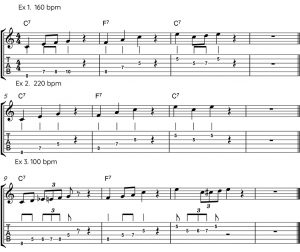Guitar Cool: What To Do When Tempos Are Just Too Quick
Guitar Cool: What To Do When Tempos Are Just Too Quick
Here’s a question guitar students often ask; “How do I play a solo, or rhythm part, when tempos are going too fast for me to physically play what’s needed?”
That’s a great question, and can be mirrored with what about playing too slow a tempo as well? That too can create problems.
Before we get into looking at practical solutions let’s start with asking how such issues might come about? You may, for example, have learnt a certain tune at 120bpm, but the band doesn’t use a metronome and it’s counted in on-stage at 130bpm or even quicker, so you find yourself playing catch up. Equally it might get counted in too slow, so losing its familiar groove and becoming difficult to play.
In another scenario you might have learnt a certain cool solo, lick, or rhythm phrase, and want to use it in a different song. But what if that song plays at half, or maybe twice the tempo of the song you got your idea from? This kind of situation occurs a lot as well.
One of the problems when learning rhythm parts, solos, fills, etc., is that when they are from a certain song played at a certain tempo they only fit that tempo – most of the time.
The first problem of songs being counted in too quickly or slowly is easy enough to fix. You can either get your band to count in at the appropriate tempo (using a metronome), or learn each of your songs a bit quicker to allow for variations in tempo if they won’t. You probably won’t find problems playing in slower tempos in this scenario, although it will affect the groove and you will likely need to adjust it using techniques explained next.
To fix problems in the second area described is a bit more complicated. If you look at the lick in Exercise 1. you can see it might be easy enough to play (depending on your ability) at the tempo of 160 bpm. However, if you want to play it in another song at 220 bpm, as in Ex 2., you might have to alter it by getting rid of a few notes – without altering the original melody too much.
In Ex 3. you can see the tempo here is quite slow, only 100 bpm. The easy way to deal with this situation is by adding a few notes to that original lick. Again, without altering the original melody too much. By keeping the beginning and end notes the same and only altering what is in the middle of the lick (which is normally the most difficult to play), you will find it’s easy to alter licks like this on the fly, no matter whether you are jamming, performing, or in the studio.
“But what about rhythm parts?” you might be asking. They really are no different. You can add more to the part if it is at a slower tempo, or take something away if at a faster tempo. Of course, even if this sounds easy to do it does sometimes take some practice to do effortlessly. To practice the idea, try this:
Get one of your favourite solo licks or rhythm ideas and sit down with your metronome and find a comfortable tempo you can play the part well, with no mistakes. Now take the metronome back about 40-50 bpm and try the same part out. Will you need to add notes to it, or not? Add something to it, then try again with different additions, trying many different things out. Remember that you must be able to play whatever it is effortlessly.
After you have done the slower version, now try raising the metronome 40-50 bpm above the original and hear how it feels. Will you need to delete a few notes? Taking the same approach, repeatedly try deleting different notes to keep that great feel going.
This is a valuable exercise to do and as a bonus adds immensely to your creative spirit. Music is, after all, a creative art and you do need to practice being more creative.
Kevin Downing is a professional guitarist, teacher, and author of six guitar educational books. His contact details, along with many freebies, are on his website.

